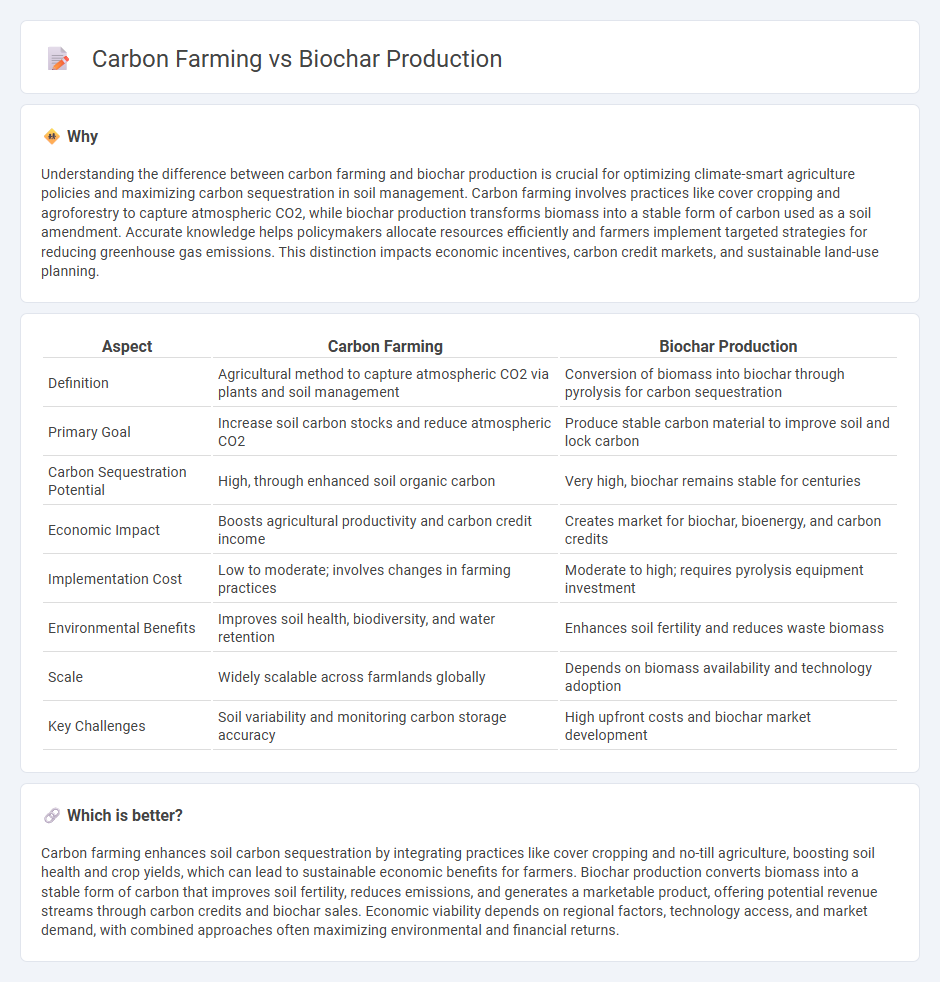
Carbon farming enhances soil carbon sequestration through techniques like cover cropping and reduced tillage, improving soil fertility and mitigating climate change. Biochar production involves converting biomass into stable charcoal through pyrolysis, which can be added to soil to increase carbon storage and boost agricultural productivity. Explore the economic impacts and sustainability potential of these innovative climate solutions.
Why it is important
Understanding the difference between carbon farming and biochar production is crucial for optimizing climate-smart agriculture policies and maximizing carbon sequestration in soil management. Carbon farming involves practices like cover cropping and agroforestry to capture atmospheric CO2, while biochar production transforms biomass into a stable form of carbon used as a soil amendment. Accurate knowledge helps policymakers allocate resources efficiently and farmers implement targeted strategies for reducing greenhouse gas emissions. This distinction impacts economic incentives, carbon credit markets, and sustainable land-use planning.
Comparison Table
| Aspect | Carbon Farming | Biochar Production |
|---|---|---|
| Definition | Agricultural method to capture atmospheric CO2 via plants and soil management | Conversion of biomass into biochar through pyrolysis for carbon sequestration |
| Primary Goal | Increase soil carbon stocks and reduce atmospheric CO2 | Produce stable carbon material to improve soil and lock carbon |
| Carbon Sequestration Potential | High, through enhanced soil organic carbon | Very high, biochar remains stable for centuries |
| Economic Impact | Boosts agricultural productivity and carbon credit income | Creates market for biochar, bioenergy, and carbon credits |
| Implementation Cost | Low to moderate; involves changes in farming practices | Moderate to high; requires pyrolysis equipment investment |
| Environmental Benefits | Improves soil health, biodiversity, and water retention | Enhances soil fertility and reduces waste biomass |
| Scale | Widely scalable across farmlands globally | Depends on biomass availability and technology adoption |
| Key Challenges | Soil variability and monitoring carbon storage accuracy | High upfront costs and biochar market development |
Which is better?
Carbon farming enhances soil carbon sequestration by integrating practices like cover cropping and no-till agriculture, boosting soil health and crop yields, which can lead to sustainable economic benefits for farmers. Biochar production converts biomass into a stable form of carbon that improves soil fertility, reduces emissions, and generates a marketable product, offering potential revenue streams through carbon credits and biochar sales. Economic viability depends on regional factors, technology access, and market demand, with combined approaches often maximizing environmental and financial returns.
Connection
Carbon farming enhances soil carbon sequestration by integrating biochar production, which converts agricultural waste into stable carbon-rich material. Biochar improves soil fertility and retains carbon for centuries, making it a critical tool for reducing atmospheric CO2 and advancing sustainable agricultural economies. This synergy supports climate-smart farming practices while generating economic benefits through carbon credits and improved crop yields.
Key Terms
Carbon credits
Biochar production enhances soil carbon sequestration by converting biomass into a stable form of carbon that remains in the soil for centuries, directly contributing to carbon credits. Carbon farming incorporates a range of practices, including biochar application, cover cropping, and agroforestry, to increase soil organic carbon and generate verifiable carbon credits through improved ecosystem services. Explore the potential of biochar within carbon farming strategies to maximize your carbon credit opportunities and environmental impact.
Cost-benefit analysis
Biochar production involves converting biomass into stable carbon-rich material through pyrolysis, enhancing soil fertility while sequestering carbon, with costs tied to feedstock, processing technology, and application. Carbon farming encompasses diverse practices, including biochar use, aimed at increasing carbon sequestration and improving land productivity, with financial benefits from carbon credits, crop yield improvements, and ecosystem services. Explore comprehensive cost-benefit analyses to understand the economic viability of integrating biochar production within broader carbon farming strategies.
Revenue streams
Biochar production generates revenue through the sale of biochar as a soil amendment, carbon sequestration credits, and bioenergy byproducts like syngas and bio-oil, forming a multi-faceted income model. Carbon farming's revenue streams rely primarily on payments for ecosystem services, including carbon offset credits, government incentives, and enhanced agricultural yields from improved soil health. Explore how integrating these approaches can maximize profitability and sustainability.
Source and External Links
Preparation of Biochar for Use as a Soil Amendment - Biochar is primarily produced by pyrolysis, which involves heating biomass in the absence of oxygen; common methods include slow pyrolysis, fast pyrolysis, gasification, torrefaction, and flash carbonization, each differing in temperature, heating rate, and residence time affecting the biochar's quality and properties.
Biochar Technology - The core biochar production process is pyrolysis, which breaks down biomass by heat without oxygen, and modern production ranges from simple pit fires to advanced pyrolysis kilns and reactors, optimizing biochar yield by excluding oxygen.
Biochar Production Technologies - Advanced biochar production includes continuous-feed pyrolyzers, rotary kilns, flash carbonizers, and gasifiers that improve energy efficiency, control product yields, and allow feedstock flexibility, with ongoing research focusing on optimizing biochar properties and co-product recovery.
 dowidth.com
dowidth.com